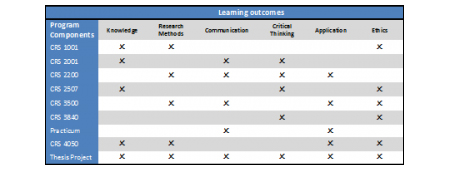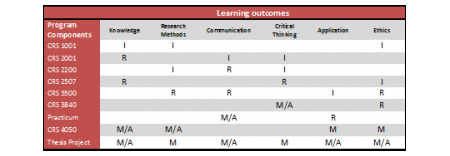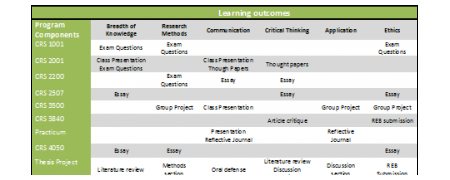Virtually all curriculum maps start with a matrix that lists courses and other program components listed across one dimension (i.e, at the start of each rows) and program learning outcomes on the other (i.e., at the top of each column). From there the map can be filled in using different strategies.
Basic Curriculum Map
 A very basic map will simply indicate which learning outcomes are addressed by each program component. This is usually done by simply inserting an “x” or a checkmark where the outcome and component align. This answers the question: “Where are learning outcomes achieved by the program?”
A very basic map will simply indicate which learning outcomes are addressed by each program component. This is usually done by simply inserting an “x” or a checkmark where the outcome and component align. This answers the question: “Where are learning outcomes achieved by the program?”
Skill Level Curriculum Map
 A more sophisticated map will tell you not only where individual learning outcome are achieved, but also the extent to which they are developed.
A more sophisticated map will tell you not only where individual learning outcome are achieved, but also the extent to which they are developed.
This can be done by indicating the level of skill students can expect to have achieved after completing the course or activity using a simple rubric.
A common rubric used is the IRMA.
Using this rubric, course alignments with learning outcomes are marked “I” where skills needed for that outcome are introduced, “R” where they are reinforced, “M” where they are mastered.
Considering that assessment usually should not occur before mastery this coding system also lets you know when and where learning outcomes assessment (marked with an “A”) should take place.
This type of curriculum map answers the question:
“When will learning outcomes be achieved by the program?”
Activity & Assessment Curriculum Maps
 An even more detailed map will tell you what specific aspects of the program will lead to specific outcomes. For this type of map, course-level activities and assignments are listed at the point where courses and outcomes are aligned. This can communicate very clearly and effectively to students the value of each assignment and exam. It can also assist with assessment by telling you which artifacts to measure for demonstration of the learning outcome. This type of map answers the question “How will learning outcomes be achieved by the program?”
An even more detailed map will tell you what specific aspects of the program will lead to specific outcomes. For this type of map, course-level activities and assignments are listed at the point where courses and outcomes are aligned. This can communicate very clearly and effectively to students the value of each assignment and exam. It can also assist with assessment by telling you which artifacts to measure for demonstration of the learning outcome. This type of map answers the question “How will learning outcomes be achieved by the program?”
You can also make multiple maps that relay different types of information. For example, you may want to create one map that describes if, and to what extent, each course contributes to each learning outcome using the IRMA scoring rubric. You may then want to create a second map that described the specific course activities that will contribute to the achievement of the learning outcomes. The two maps can be combined, or used separately depending on what you are using it for, or who you are communicating with.
Curriculum Map Template
Gathering the Data to Map
To accurately and effectively map your curriculum, you will need to identify all of the relevant components of your program (and possibly the activities within them) that contribute to, and support learning. This has been referred to as course and program stocktaking. Although course offerings are often the most easily recognized “program component,” there may be other aspects of your program that you should considers including. Thesis and capstone research projects, lecture series, practicums, and co-op placements are all ways in which students learn outside of the traditional classroom.
Program and course stocktaking can be accomplished in several ways. Some methods are listed below:
- Committee discussions
- Faculty and students surveys
- Calendar course descriptions and other official documentation
Your completed curriculum map is an important tool you can use to explore and assess your program. It can help you answer the following important questions about your program:
- Are program learning outcomes addressed in a logical order?
- Do students get practice in a skill before they are expected to demonstrate mastery?
- Do some outcomes get covered more than others?
- Are learning outcomes achievable through multiple means?
A curriculum map that shows the level of skill achieved with each component will easily tell you if there are gaps in skill development or errors in the sequencing of acquired skills. Skills needed to achieve different learning outcomes typically need to be introduced before they are reinforced, and reinforced before they are mastered. For example, it is unrealistic to expect a student to demonstrate mastery of research methods while conducting their thesis research after only being introduced to the basic concepts of research design in the introductory course.